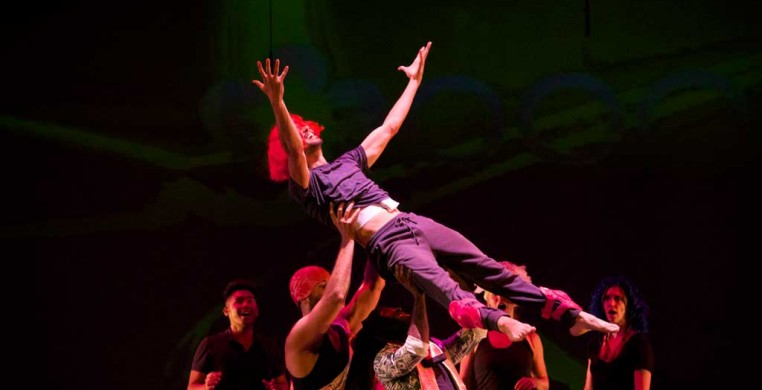Corporate buzz words abound as a disparate collection of out of work comic book superheroes tries to reinvent itself into a corporate entity for today’s marketplace in Lucky Plush Productions’ “Trip The Light Fantastic: The Making of SuperStrip,” presented at The Dance Center, Columbia College September 29-October 1.
The composite title is a road map with two distinct routes in LPP artistic director Julia Rhoads' evening-length, multi-disciplinary work. The collage of scripted dialog, digital technology, narration, and choreographed dance sequences aspires to tell the story of the superheroes' muddled efforts. Along the way we are treated to some marvelous dancing, a cast of endearing if misguided characters, and some dazzling high-tech video effects.
“SuperStrip” is at its best when the dancing, Michael Caskey’s original music, and Liviu Pasare’s video/media design intersect to create a truly thrilling visual spectacle. This is accomplished with ten moveable square panels, initially stacked across the upstage wall to look like comic book frames. The panels serve primarily as projection surfaces for both representational and abstract images, but occasionally they enter the choreography as spatial partners with the dancers.
Highly athletic choreographed segments intersperse storytelling with a rich, sweeping movement vocabulary that takes the space with exciting ensemble dancing and inventive, acrobatic partnering that is a joy to watch. This is the “tripping the light fantastic” route of the title's road map, a reference, perhaps, to the 1894 song, “Sidewalks of New York,” where “boys and girls together, me and Mamie O’Rourke, trip the light fantastic” in a carefree, fun universe. But what of the SuperStory?
,
“The Making of SuperStrip” part of the title leads us down the rabbit hole of storytelling, sort of. Graciously guided by Onstage Media Performer, Sojourner Zenobia, we learn that our hapless collection of superheroes has been meeting regularly to develop a business plan in a chicken or egg dilemma in which they try to articulate the all-important “mission” while at the same time finding a catchy name for their collective endeavor. This is accompanied by various sacred rituals that get systematically scrapped as the corporate monster subsumes their altruistic (substitute: “artistic”) aspirations. Once established, the conceit that even superheroes can get lost in the morass of corporate marketing becomes repetitive, its clever references to Madison Avenue-speak notwithstanding.
More interesting are the individual super powers each character describes in a meet and greet format. Especially ribbitting, I mean riveting, is Michel Rodriguez Cintra’s charmingly astounding frog-man, Springster, whose narrative line is both hilarious and strangely believable. His dancing dominates in a wholly unassuming virtuosity that makes the entire evening worth the price of a ticket.
As adorable as Melinda Jean Myers’ slightly clueless Mmm character and Elizabeth Luse’s deliciously obnoxious Professor Visioné, I wanted more from each character; more story, more movement that tells their stories, more consequences for each. If they need to save the world in order to fulfill their personal destinies, then let us see them try. And let us feel the intensity of what’s at stake for each of them. As it stands, there is a lot of talking about their ideas but scant action showing their efforts to put them in motion. As the ensemble asks of The Big Liberjinski (Jamy Meek), “What’s the Big Idea?” There are many big ideas hiding inside “SuperStrip,” that meander across a production which has not yet evolved tightly-structured scenes that build a plot line upon which to to hang their stories.
The ensemble carries off parodies of over-intellectualization and academy gobbledegook, psycho-babble corporate therapy, one-ups-man-ship, and the benefits of breast milk with naturalistic acting-that’s-not-acting nonchalance that both works for and fights against effective storytelling. On the one hand, it renders the characters as authentic, believable inhabitants of today’s media world, but on the other, it robs them of their distinctly oversize comic book personas. That is to say, they are too normal, except when they are dancing, but there isn’t enough of that, or enough development within the choreography to represent their bigger than life super hero stories and their dream of “putting the ‘do’ back in do-gooding.”
While the characters and their unique super powers initially grab our attention, we don't have the pleasure of accompanying them in their struggle on a journey of discovery and transformation. What’s missing is seeing them in action as the super heroes they were, and attempting to reinvent themselves as do-gooders in a redefined world, more of a living comic book than the fictional comic book world these characters have fled. The metaphor, and its attendant ironies, are too good to pass up, and yet, “SuperStrip” literally dances around them, never quite nailing its point.
The four scripted scenes consist of the group ineffectually trying to problem-solve, over and over again, each scene recapped in Zenobia’s narration with comic-book style illustrations projected onto the upstage panels. The danger of telling a story about characters who don't go anywhere is a story that doesn't go anywhere. The story we want—how do these wanna-be do-gooders self actualize—has yet to be told, which may be Rhoads’ fatalistic point. But why settle for that with such a wealth of wonderful material at hand?

